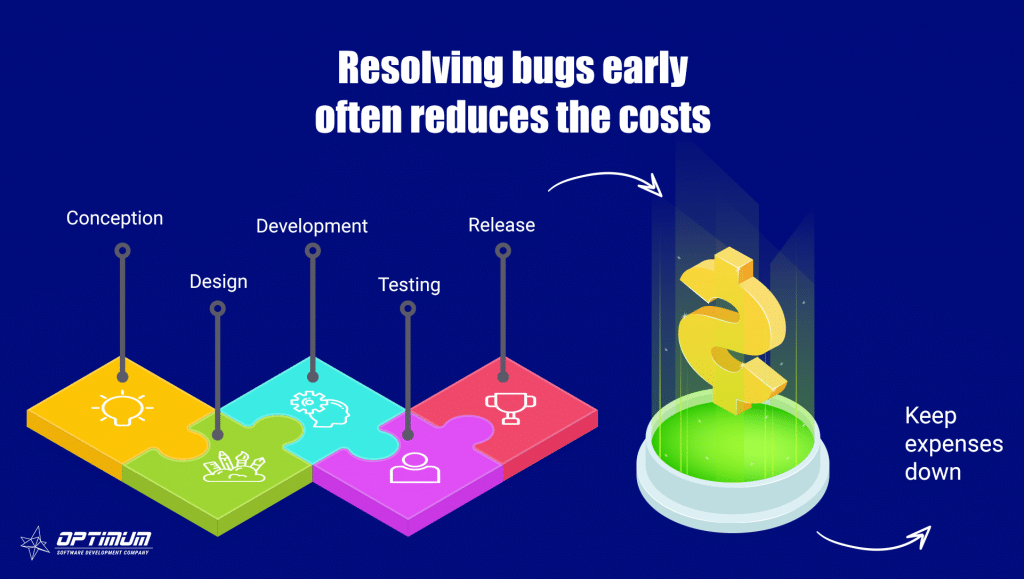
Software development, like any other activity done for profit, must focus on three things: a high-quality product or service, client satisfaction, and cost reduction. While the importance of the first two aspects is evident for maintaining stable and growing revenue, the third one may seem less crucial when income is high.
However, this is the wrong approach. The more significant the cost reduction achieved within the development process, the greater the profit in the end. This doesn’t mean you have to cut costs on developers’ salaries, the hardware they work on, or professional tools. The most substantial cost during and after the completion of work is that of mistakes.
Balancing the allocation of resources, optimizing processes, and minimizing mistakes are commonly accepted practices for achieving efficiency and maximizing returns. However, the specific strategies for achieving these goals may vary depending on the nature of the software development project, industry, and organizational context.
The cost of software failure.
Never underestimate the cost of a bug. It may seem insignificant when it goes unnoticed, but it can lead to serious problems later, potentially destroying the entire work, impacting the quality of your product, and, consequently, your customers’ satisfaction. This is the quickest way to lose your money. Sometimes, it’s wiser to invest more in overall testing during the development stage rather than dealing with reputational costs and financial losses later. So, test. Test until you’re sure there’s nothing left that could cause major issues and disappoint the end user.
According to the Department of Commerce’s National Institute of Standards and Technology, the US economy loses around $60 billion every year due to software bugs. A single bug, detected in the requirement gathering phase, may cost you $100. Not much, compared to the final price of the product. However, as it persists through all development stages until production, the price you may pay for it grows dramatically and can easily reach $10,000. We’re still talking about a single bug, remember? Just one. Now, imagine how much you could lose because of several bugs in the final stage of the product delivery process.
Furthermore, the impact of a bug extends beyond monetary losses. It can harm your brand reputation, erode customer trust, and lead to legal implications in certain cases. A flawless product not only attracts customers but also retains them, fostering long-term business relationships.
The earlier a bug is detected, the less time and resources will be needed to eliminate it, and the smaller the consequences will be. Software testing and early bug fixes turn out to be much cheaper than those that appear during the release stage. Prevention is better than a cure.
and finally, treating software testing as an integral part of the development process is not just about avoiding financial losses; it’s about building a resilient product, maintaining a positive brand image, and ensuring customer satisfaction throughout the product’s lifecycle.
Benefits of software testing and quality assurance.
As the two critical components of excellent software creation, testing and QA can do a lot for you to successfully create the best product and sell it for a fair price. Let’s explore the benefits of this unbeatable combination that your business can enjoy.
Save Your Money:
As we already know, a bug in the production stage can be very expensive, and more of them can cause enormous financial and reputational loss. It’s much cheaper to detect them in the early stages using QA testing.
Prevent Corporate Catastrophes:
Bugs in corporate software are even more dangerous as they can provoke costly consequences like missing data, system blackouts, or communication collapses.
Earn Customer Trust:
Ensuring your clients that software quality is your priority and delivering them a perfect product builds a long-term relationship. Its fruits are precious and include your reputation and prosperity.
Provide a Wonderful User Experience:
A customer who receives a high-quality product that doesn’t need additional adjustments after launch can be called a happy one. This can only be achieved by thorough bug prevention and elimination. Investing in testing during the development stage is wise, rather than disproportionately losing more time and money on post-production bug removal. When a customer is satisfied, they are likely to share their positive feelings with others, bringing you more clients. Personal communication of positive experiences is more effective than reviews, ads, and blog articles.
Increase Profit:
A high-quality product can be sold at a price sufficient to cover all expenses and investments, resulting in a decent income for the participants. Meanwhile, a customer frustrated with multiple software failures is more likely to demand a refund.
Achieve High Productivity and Efficiency:
QA testing ensures order, speed, and smoothness in the development process, as well as the final product’s quality result. Combining QA and testing is a win-win strategy for you, your customers, and their users. You spend less time and financial resources on development, your client gets a correctly working product, and the end-users are satisfied with their experience.
Automated Testing: Why Implement?
One of the most important factors ensuring testers’ productivity is reducing testing time, which can be achieved through automation. Of course, automated testing can’t be applied to all operations and testing stages, but it can save enormous amounts of time on some of them:
the repetition of the same test case
tiresome and monotonous test cases
multiple running of cases with different conditions
the need to save time for higher-priority tasks
many browsers and environments required for test case execution
Conclusion
Any business aiming for profits should do its best to minimize the cost of the production process without compromising the final product’s quality. Certainly, this must also be true when we talk about development. The best cost-cutting measures a software development company can undertake are quality assurance and testing, which more than cover all the investments. Debugged code results in a high-quality product, benefiting the developer, the client, and the end-users, who are fully satisfied with the product they use. “Clean code – big income” should be the motto of those who want to make money with development.



